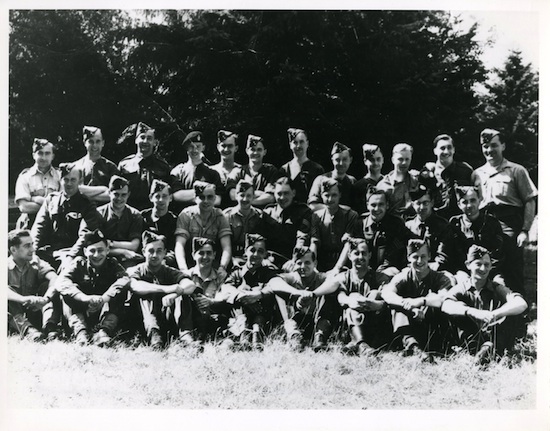 Dale Gervais – September 15, 2013
Dale Gervais – September 15, 2013
Norman Quick was born in Toronto, Ontario on April 22, 1921. As a youth, Norm carried camera equipment for his father, Charles James Quick, who worked in the 1920s with the the Ontario Motion Picture Bureau and was involved in the production of the well-known feature film “Carry On Sergeant” in 1927. Two years later, Director Frank Badgley brought Charlie to Ottawa to join the Canadian Government Motion Picture Bureau, the forerunner of the National Film Board.
At the outbreak of war in 1939, Norman enlisted with the Canadian Medical Corps, undertaking training at Camp Borden. After making no less than seven requests, he obtained a posting overseas.
Landing in Britain in December 1942, Norm served at the Alton Convalescent Hospital before getting orders to join the Canadian Film and Photo Unit (CFPU) in London.
During June and July 1943, he trained as a combat cameraman at Pinewood Studios, where he remembers meeting the great Hollywood director Frank Capra. As a member of No. 2 Canadian Public Relations group, Sergeant Quick sailed for Italy, filming a German aerial bombing attack on his convoy before disembarking at Naples in November 1943.
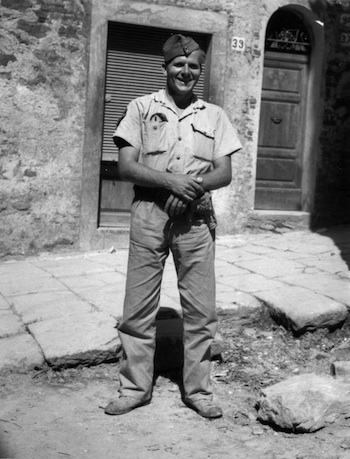 Sgt. Norman Quick was the last surviving member of the Italian theatre with the First Army Brigade. Stationed in Italy as part of the Canadian Army Film and Photo Unit, Quick was a first-hand witness to some of the most ferocious fighting outside France, documenting bloody campaigns like the Battle of Ortona, also known as “Little Leningrad,” the Gustav Line, the Hitler Line and the Battle for Cassino.
Sgt. Norman Quick was the last surviving member of the Italian theatre with the First Army Brigade. Stationed in Italy as part of the Canadian Army Film and Photo Unit, Quick was a first-hand witness to some of the most ferocious fighting outside France, documenting bloody campaigns like the Battle of Ortona, also known as “Little Leningrad,” the Gustav Line, the Hitler Line and the Battle for Cassino.
Norman would often tell the story about an Italian teenage boy named Elio, whose family could no longer support him. Norman agreed to take Elio along with his film crew during their push through Italy. Norman always wondered about whatever happened to Elio. Norman lovingly recalls how the young boy would address him as ‘Armano Sergenta Presto’.
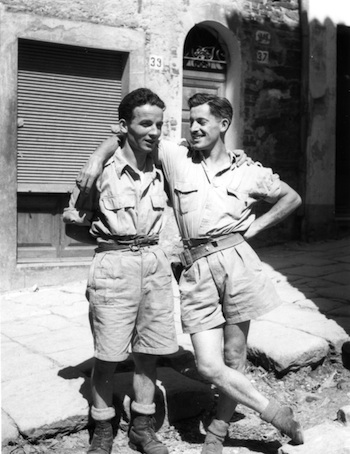 Norm won a Mention in Despatches for “all-round performance of his duties in Italy” in recognition of “gallant and distinguished services”, as well as the Italian Star, the France-Germany Star and the 1939-45 Star.
Norm won a Mention in Despatches for “all-round performance of his duties in Italy” in recognition of “gallant and distinguished services”, as well as the Italian Star, the France-Germany Star and the 1939-45 Star.
Norman recounts a story while stationed in Italy. Norman Quick and other members of the Unit were on hand when a young Italian boy came running into their camp to say that a Canadian cameraman had been wounded. Norman recalls running ‘like hell’ down the road to be first on the scene to aid his colleague Sgt. Andy Anderson who was hit by shrapnel. Norman stopped the bleeding and he and his driver loaded Sgt. Anderson and his camera equipment onto a jeep and got him to a casualty clearing station that ended up saving his life.
Norman would tell the story about being in Holland during the winter, when many of the Dutch people were suffering from hunger. He recalls how Dutch children would often beg for food but on one occasion Norman was rebuffed by the military to not fraternize with the population. Norman recalls how he defiantly entered the canteen and persuaded the cook to make scrambled eggs for the starving children.
Norman and Ernie DeGuire of Kemptville, were the last two Film Unit men to leave Italy, travelling north to reach Nijmegen in March 1945. After two arduous years in Italy, Norm was expecting some leave in Britain, but had to go into action right away filming Canadian units fighting in the Reichswald Forest. He followed the advance through Northwest Europe to Oldenburg, entering the port of Wilhelmshaven two days before the ceasefire in May 1945.
 After the war, Norm Quick became a cameraman with the National Film Board from 1945 to 1951, and then rejoined the Army for another eighteen years of service before his retirement in 1969. Some of the films he worked on are currently housed at Library and Archives Canada.
After the war, Norm Quick became a cameraman with the National Film Board from 1945 to 1951, and then rejoined the Army for another eighteen years of service before his retirement in 1969. Some of the films he worked on are currently housed at Library and Archives Canada.
In March 2010 The Canadian Society of Cinematography (CSC) presented the CSC COMBAT CAMERA AWARD, a special achievement award to the Canadian Army Film and Photo Unit (CFPU) during its annual awards banquet held in Toronto on March 27th.The CSC award recognizes “the outstanding achievements of the CFPU during the war, in honour and remembrance of the courageous cameramen of the Second World War.”
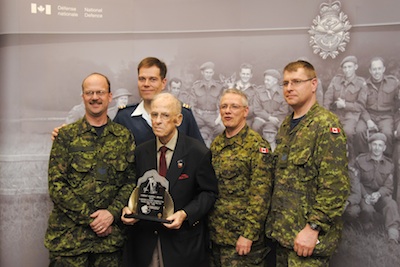 On hand to accept the award was Norman’s colleague Chuck Ross, as well as two members of Canada’s Combat Camera.
On hand to accept the award was Norman’s colleague Chuck Ross, as well as two members of Canada’s Combat Camera.
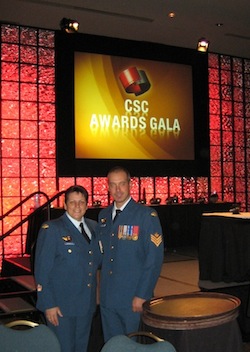
“The members of Combat Camera and the image technician branch are proud of our Canadian Army Film and Photo Unit’s heritage. They are a constant source of inspiration for all the Canadian Forces serving members. They have accomplished so much, with so little in recording history for future generations. It is our honour to carry on this tradition of recording today’s history for tomorrow’s generation. Looking back at the astonishing work they accomplished despite all obstacles, we are both humbled and honoured to carry on their legacy. In many ways, the Canadian Army Film and Photo Unit is, and will be remembered as the real pioneers of Combat Camera and the Canadian film industry.
Thank You Mr. Ross, Thank you to the Canadian Society of Cinematography for recognizing them, and thank you to all the veterans past and present to allow us to remember this part of history forever.” WO Carole Morissette.
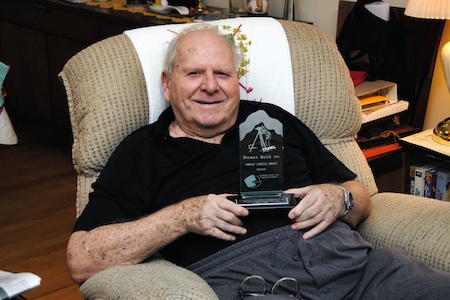
Norman will be remembered by people here at home in Canada, as well as many friends overseas in Holland and Italy. In a letter to Norman from the Embassy and Consulates of the Kingdom of the Netherlands, dated, Ottawa, 13 March, 2012;
“Congratulations on celebrating your 91st birthday next month. I would like to add to the occasion my personal best wishes. As you know the Dutch will always be grateful to the Canadian veterans who helped liberate the Netherlands in 1945. Even today the Dutch people remember and are grateful for your efforts. I wish you a wonderful celebration and trust that this birthday may be followed by many years of joy and happiness.
Commander Frits Stam
Defence Attaché”
Also from Holland Norman is a letter from Martin Hols;
“Eelde, 8th December 2008
Dear Mr. Quick,
As an amateur historian I am very interested in the history of the liberation of the Netherlands by Canadian armed forces at the end of World War II in 1944/1945. My interest is caused by the fact that in my (now) former dwelling place Holten, in the eastern part of the Netherlands, a Canadian war cemetery is situated, where about 1350 Canadian soldiers rest. During my youth we several times had Canadian guests at home, who visited the Netherlands on a pilgrimage tour. Also the fact that I, as a boy scout, often had to assist in laying wreaths at the Cross of Sacrifice in the centre of the cemetery of Holten, often lead this history to my attention.

Several weeks ago I did some research on the internet and read some about the Canadian F&P unit during the war. I also read information written by Dale Gervais about you. Seeing pictures of you I saw some resemblance with the camera man near Holten…For me this was the proof that it was you, being in action as a member of the F&P-unit near Holten.
Dear Mr. Quick I hope you understand and appreciate my interest in this subject. I was very lucky to trace the pictures that were taken near Holten. Beside the pictures I later also recognized flashes of the same places and circumstances in Canadian Anny Newsreels. I think that it is likely that [you] took those moving shots.
With kind regards, also wishing you a Merry Christmas and a Happy 2009,
Martin J.G. Hols”
Flying in all the way from Holland was Herman Steunenberg, who as a pilot for the Royal Dutch Airlines, brought along his brother to chat with Norman about his role in Holland, and to meet one of the Canadian combat cameramen that travelled with the Canadians in the drive to liberate his town of Holten.
He will be remembered in Italy by Paolo Sbarbada who documented and followed the involvement of Canadians in Sicily, and by Mariangela Rondinelli who loved to talk to Norman on the ‘phone and he loved to speak Italian!
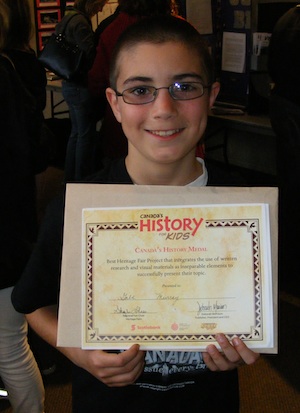
Norman Quick was the inspiration for many young students that were impressed with his achievements, and chose him for their school projects. One such student was Serge Atkinson, who did well enough at his school’s Heritage Fair to win a prize at Brock University for his presentation about Norman Quick and the Film Unit. Serge continues to honour Norm and the Film Unit by keeping a picture of Norman on his side table.
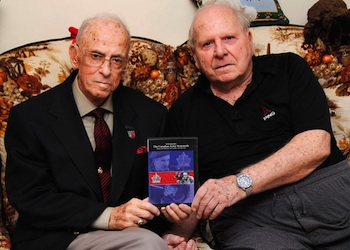 Norman Quick was instrumental in aiding The War Amps with the release of their historical boxed set of all 106 Issues of the Canadian Army Newsreels. He will be remembered for his quick wit and sharp memory to recall events of so many years ago. He leaves behind the inspiration to a website devoted to keeping alive the memory and historical achievements of all Canadian combat cameramen and women.
Norman Quick was instrumental in aiding The War Amps with the release of their historical boxed set of all 106 Issues of the Canadian Army Newsreels. He will be remembered for his quick wit and sharp memory to recall events of so many years ago. He leaves behind the inspiration to a website devoted to keeping alive the memory and historical achievements of all Canadian combat cameramen and women.
Norman Quick has also been featured several times in the Ottawa newspapers, and was also featured on television in a story written by the CBC’s Reg Sherren, presented by Peter Mansbridge, on CBC The National on Remembrance Day November 7th, 2011. In it Norman recounts his career as combat cameraman with the Film & Photo Unit.

Norman Quick and the Film Unit are also an honoured part of the personnel at the Department Public Affairs Learning Centre, that trains young Canadian military recruits in the photographic and video arts. There were four members of the Canadian Film & Photo Unit on hand in November of 2009 to witness “an historic event for us as we symbolically pass the torch of the combat cameramen, newsmen and film editors from the Second World War to our own contemporary Public Affairs Officers and Non-Commissioned Members. What we will be experiencing next week as members of the Public Affairs and Image Technicians’ Branch is the transcendence of time and space where we will officially recognize the achievements of our veterans by providing their unit a permanent spiritual home in our school while binding our association with our war-time forebears – something which has never occurred in 70 years.”
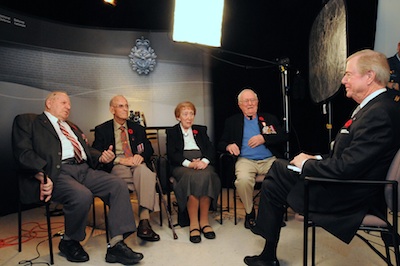
IS2009-4011-03
10 November 2009
Gatineau, Quebec
Left to Right: Sergeant Norman Quick (Ret), Sergeant Charles Ross (Ret), Sergeant Nadine Manning (Ret), Captain Michael Spencer sit in an interview with CBC’s Don Newman.
The Defence Public Affairs Learning Centre (DPALC) in Gatineau Quebec, dedicates it’s technical wing to the Candian Forces Photo Unit, which runs courses on media techniques and technologies. On hand for the occasion were the guests of honour Captain Michael Spencer (Ret), Sergeant Norman Quick (Ret), Sergeant Charles Ross (Ret), and Sergeant Nadine Manning (Ret), Canadian veterans of the Army Movie and Photo unit from World War II.
Working hand in hand with the Canadian Forces Public Affairs branch, Canadian Forces Imagery Technicians continue to record the current events of the Canadian Forces into history, for future generations.
Photos By: MCpl David Cribb
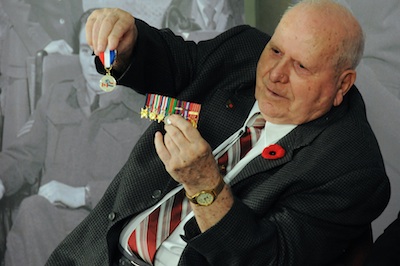
IS2009-4011-01
10 November 2009
Gatineau, Quebec
Sergeant Norman Quick displays his medals during an interview at the dedication Defence Public Affairs Learning Centre (DPALC) in Gatineau, Quebec.
The Defence Public Affairs Learning Centre (DPALC) in Gatineau Quebec, dedicates it’s technical wing to the Candian Forces Photo Unit, which runs courses on media techniques and technologies. On hand for the occasion were the guests of honour Captain Michael Spencer (Ret), Sergeant Norman Quick (Ret), Sergeant Charles Ross (Ret), and Sergeant Nadine Manning (Ret), Canadian veterans of the Army Movie and Photo unit from World War II.
Working hand in hand with the Canadian Forces Public Affairs branch, Canadian Forces Imagery Technicians continue to record the current events of the Canadian Forces into history, for future generations.
Photos By: MCpl David Cribb
Norman will also be fondly remembered by the surviving members of the Film & Photo Unit, who like them, put their lives on the line in order to get the films and photos, along with the stories of the men and women of the Canadian Armed forces sent back home.
There is Michael Spencer of Montreal, who was one of the original four members to form the Film Unit, and was appointed Member of the Order of Canada in 1989 for his part in the creation of the Canadian film industry. Norman will be missed by his close friend Dave King of Vancouver, who was wounded as a driver while on assignment with the Film Unit in Italy. And Nadine Manning of Beaconsfield who worked in the Film Unit Library, as well as Graham Campbell of Oakville, another Combat Cameraman who served in the Film Unit along with Norman.
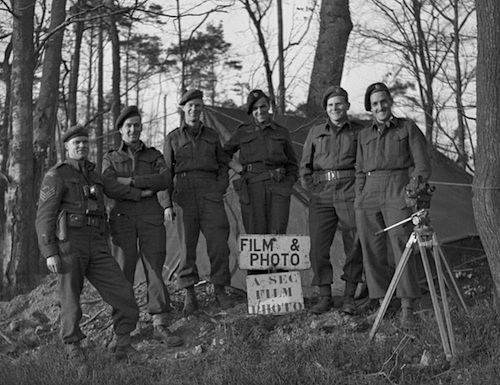
Norman Quick after suffering a bad fall and surgery to repair a broken femur, died peacefully at The Ottawa Hospital (Civic Campus). He was 92 years old.
Dale Gervais – September – 2013
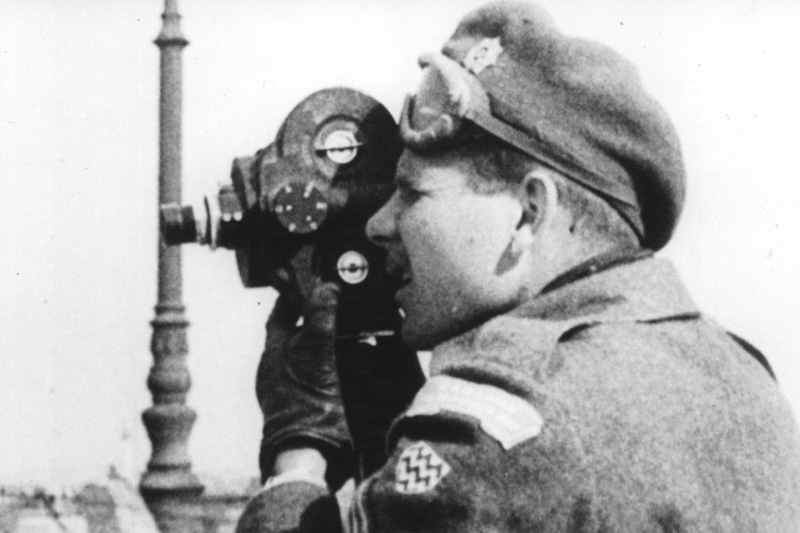



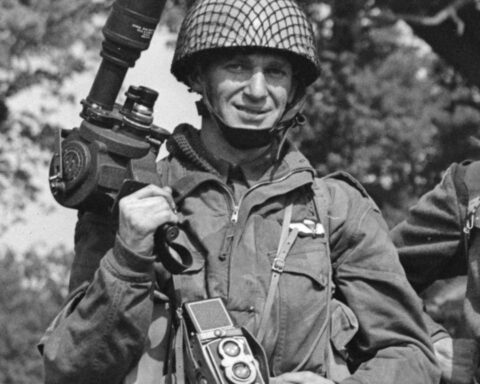


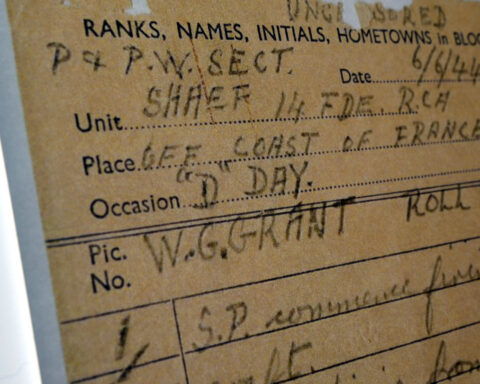




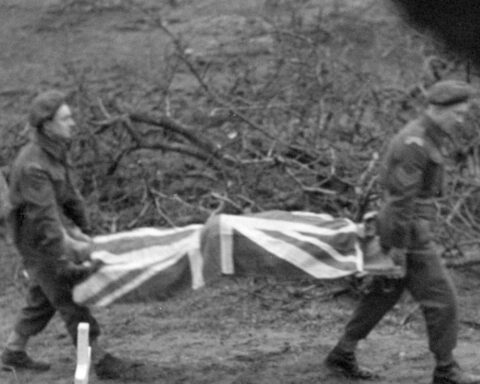


[…] Remembering ‘Stormin’ Norman (Norman C. Quick, CSC; 1921-2013) […]